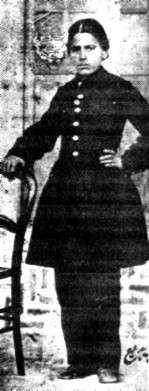Badíʻ
Badíʻ (Arabic: ﺑﺪﻳﻊ 1852 – 1869) was the title of Mírzá Áqá Buzurg-i-Nishapuri, also known by the title the Pride of Martyrs. He was the son of ʻAbdu'l-Majid-i-Nishapuri, a follower of the Báb and Baháʼu'lláh.

| Part of a series on the |
| Apostles of Baháʼu'lláh |
|---|
 |
Badíʻ is most famous for being the bearer of a tablet written by Baháʼu'lláh to Nasiri'd-Din Shah, for which he was tortured and killed at the age of 17. He is also one of the foremost Apostles of Baháʼu'lláh.
The Kitáb-i-Badíʻ, a book written by Baháʼu'lláh, has no relation to the Badíʻ of this article.
Travels
Although Badíʻ's father was a Baháʼí, Badí was originally not touched by the new religion.[1] He was an unruly and rebellious youth, and his father described him as the "despair of the family".[2] It was upon a meeting with Nabíl-i-Aʻzam that Badíʻ heard a poem by Baháʼu'lláh and began weeping. After finishing his studies, he gave away his possessions and set out on foot for Baghdad, where a significant number of Baháʼís were under persecution. Finally he set out on foot from Mosul through Baghdad to the prison city of ʻAkka.[1]
As guards protected against Baháʼís entering ʻAkka, Badí dressed as a water-carrier and slipped by the guards, and then proceeded to a mosque, where he recognized ʻAbdu'l-Bahá and gave him a note. Badíʻ received two interviews with Baháʼu'lláh, and requested that he deliver the Lawh-i-Sultán, Baháʼu'lláh's tablet to Nasiri'd-Din Shah. He received the tablet in Haifa to avoid being caught by Ottoman officials. From there he travelled on foot for four months to Tehran. Along the way he was reported to "be full of joy, laughter, gratitude and forbearance, walking around one hundred paces then leaving the road and turning to face ʻAkká. He would then prostrate himself and say: 'O God, that which you have bestowed upon me through Your bounty, do not take back through Your justice; rather grant me strength to safeguard it'".[2][1]
Execution
After three days of fasting, Badíʻ went to the Shah's summer camp, and the Shah came upon him while hunting in the woods. Badíʻ approached the monarch with respect and calmly said: "O King! I have come to thee from Sheba with a weighty message". Badíʻ was arrested, branded for three successive days, his head beaten to a pulp with the butt of a rifle, after which his body was thrown into a pit and earth and stones heaped upon it.[1]
A particularly famous picture of Badíʻ exists, taken at the Shah's request, where he is in chains during his torture, showing no emotion.
Haji Abdu'l-Majid
The 85-year-old grandfather of Badíʻ, Haji Abdu'l-Majid, a survivor of the Battle of Fort Tabarsi, was also killed. According to Shoghi Effendi:
After the martyrdom of his son, [Haji Abdu'l-Majid] had visited Baháʼu'lláh and returned afire with zeal to Khurasan, [where he] was ripped open from waist to throat, and his head exposed on a marble slab to the gaze of a multitude of insulting onlookers, who, after dragging his body ignominiously through the bazaars, left it at the morgue to be claimed by his relatives.[3]
See also
- Badi' calendar
Notes
- Taherzadeh, A. (1984). The Revelation of Baháʼu'lláh, Volume 3: ʻAkka, The Early Years 1868-77. Oxford, UK: George Ronald. pp. 176–187. ISBN 0-85398-144-2.
- Francis, Richard (2001). "Áqá Buzurg (Badíʻ) the Pride of the Martyrs".
- Effendi, Shoghi (1944). God Passes By. Wilmette, Illinois, USA: Baháʼí Publishing Trust. p. 200. ISBN 0-87743-020-9.
References
- Balyuzi, H.M. (1985). Eminent Baháʼís in the time of Baháʼu'lláh. The Camelot Press Ltd, Southampton. ISBN 0-85398-152-3.
- Effendi, Shoghi (1944). God Passes By. Wilmette, Illinois, USA: Baháʼí Publishing Trust. ISBN 0-87743-020-9.
- Nabíl-i-Zarandí (1932). Shoghi Effendi (Translator) (ed.). The Dawn-Breakers: Nabíl's Narrative (Hardcover ed.). Wilmette, Illinois, USA: Baháʼí Publishing Trust. ISBN 0-900125-22-5.
External links
| Wikimedia Commons has media related to Badi. |
- Áqá Buzurg (Badíʻ), the Pride of the Martyrs, biography by Richard Francis (2001).
- Biography, by Moojan Momen.